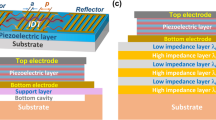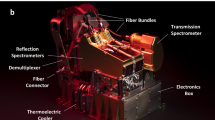Abstract
A heterodyne receiver using an SIS waveguide mixer with two mechanical tuners has been characterized from 480 GHz to 650 GHz. The mixer uses either a single 0.5 × 0.5 µm2 Nb/AlOx/Nb SIS tunnel junction or a series array of two 1 µm2 Nb tunnel junctions. These junctions have a high current density, in the range 8 – 13 kA/cm2. Superconductive RF circuits are employed to tune the junction capacitance. DSB receiver noise temperatures as low as 200 ± 17 K at 540 GHz, 271 K ± 22 K at 572 GHz and 362 ± 33 K at 626 GHz have been obtained with the single SIS junctions. The series arrays gave DSB receiver noise temperatures as low as 328 ± 26 K at 490 GHz and 336 ± 25 K at 545 GHz. A comparison of the performances of series arrays and single junctions is presented. In addition, negative differential resistance has been observed in the DC I–V curve near 490, 545 and 570 GHz. Correlations between the frequencies for minimum noise temperature, negative differential resistance, and tuning circuit resonances are found. A detailed model to calculate the properties of the tuning circuits is discussed, and the junction capacitance as well as the London penetration depth of niobium are determined by fitting the model to the measured circuit resonances.
Similar content being viewed by others
References
G. de Lange, C.E. Honingh, M.M.T.M. Dierichs, R.A. Panhuyzen, H.H.A. Schaeffer, T.M. Klapwijk, H. van de Stadt, M.W.M. de Graauw, "A low noise 410–495 Heterodyne two tuner mixer using submicron Nb/Al2O3/Nb tunnel junctions," Proceedings of the 3rd Int. Symposium on Space Terahertz Technology, pp. 210–221, Ann Arbor, MI, March 24–26, 1992.
M. Salez, P. Febvre, W.R. McGrath, B. Bumble, H.G. LeDuc, "An SIS waveguide heterodyne receiver for 600 GHz to 636 GHz," Int. J. of Infrared and Millimeter Waves, vol. 15, no. 2, pp. 349–368, February 1994.
J. Zmuidzinas and H.G. LeDuc, "Quasioptical slot antenna SIS mixers," IEEE Trans. Microwave Theory Tech., vol. 40, no. 9, pp. 1797–1804, September 1992.
W.R. McGrath, K. Jacobs, J. Stern, H.G. LeDuc, R.E. Miller, M.A. Frerking, "Development of a 600- to 700-GHz SIS receiver," Proceedings of the 1st Int. Symposium on Space Terahertz Technology, pp. 409–433, Ann Arbor, MI, March 5–6, 1990.
H.G. LeDuc, B. Bumble, S.R. Cypher, A.J. Judas, J.A. Stern, "Submicron area Nb/AlOx/Nb tunnel junctions for submillimeter mixer applications," Proceedings of the 3rd Int. Symposium on Space Terahertz Technology, pp. 408–418, Ann Arbor, MI, March 24–26, 1992.
P. Feautrier, M. Hanus and P. Febvre, "Nb/Al-AlOx/Nb junctions for a 380 GHz SIS Receiver," Supercond. Sci. Technol., vol. 5, pp. 564–568, 1992.
S. Ramo, J.R. Whinnery, and T. Van Duzer,Fields and Waves in Communication Electronics., pp. 460–463, John Wiley and sons, Inc., New York 1965–1984.
B.A. Syrett, "A Broad-Band Element for Microstrip Bias or Tuning Circuits," IEEE Trans. Microwave Theory Tech., vol. MTT-28, pp. 925–927, August 1980.
A.V. Raisanen, W.R. McGrath, P.L. Richards and F.L. Lloyd, "Broad-band rf match to a millimeter-wave SIS quasi-particle mixer," IEEE Trans. Microwave Theory Tech., vol. MTT-33, pp. 1495–1500, 1985.
K. Jacobs, U. Kotthaus, "Performance of a 230 GHz SIS receiver using Broadband Integrated Matching Structures," Digest of the 17th Int. Conf. on Inf. and Millimeter Waves, pp. 332–333, California Institute of Technology, Pasadena, California, December 14–17, 1992.
The series transformer circuit becomes increasingly difficult to implement for large values of susceptance 2πfSCJ since the first stage of transformation then results in a very low real impedance. This approach is thus not expected to be as useful for higher frequencies fS, and/or large junction capacitance.
T.R. Gheewala, “Design of 2.5-micrometer Josephson current injection logic,” IBM J. Res. Develop., vol. 24, pp. 130–142, 1980.
W.M. Chang, "The inductance of a superconducting strip transmission line," J. Appl. Phys., vol. 50, pp. 8129–8134, 1979.
J.C. Swilhart, “Field solution for a thin film superconducting strip transmission line,” J. Appl. Phys., vol. 32, pp. 461–469, 1961.
H.H.S. Javadi, W.R. McGrath, B. Bumble, and H.G. LeDuc, “Dispersion in Nb microstrip transmission lines at submillimeter wave frequencies,” Appl. Phys. Lett., vol. 61, pp. 2712–2714, 1992.
H.A. Wheeler, "Transmission-Line Properties of a Strip on a Dielectric Sheet on a Plane," IEEE Trans. Microwave Theory Tech., vol. MTT-25, pp. 631–647, 1977.
F. Giannini, R. Sorrentino and J. Vrba, "Planar Circuit Analysis of Microstrip Radial Stub," IEEE Trans. Microwave Theory Tech., vol. MTT-32, pp. 1652–1655, 1984.
G. Kompa, "Design of stepped microstrip components," The Radio and Electronic Engineer, vol.48, no. 1/2, pp. 53–63, January/February 1978
R.E. Matick,Transmission Lines For Digital and Communication Networks, sec. 6.4, McGraw-Hill, New York, 1969.
R.L. Kautz, "Picosecond pulses on superconducting striplines," J. Appl. Phys., vol. 49, no. 1, pp. 308–314, 1978.
D.C. Mattis and J. Bardeen, Phys. Rev, vol. 111, pp. 412–417, 1958.
R.D. Parks (ed.)Superconductivity, vol. 1, pp. 193–258, Marcel Dekker, Inc, New York 1969.
K. Jacobs, and W.R. McGrath, "Large scale modeling of a submillimeter wave SIS mixer with integrated tuning elements," Digest of the 14th Int., Conference on Infrared and Millimeter Waves (M. von Ortenberg, ed.), pp. 539–540, Wurzburg, Germany, 1989.
H.M. Pickett, J.C. Hardy, J. Farhoomand, “Characterization of a dual-mode horn for submillimeter wavelengths,” IEEE Trans. Microwave Theory Tech., vol. MTT-32, pp. 936, 1984.
Made by Radiometer Physics, Meckenheim, Germany.
R.E. Eck, D.J. Scalapino and B.N. Taylor, “Self-detection of the ac Josephson current,” Phys. Rev. Lett., vol. 13, no. 1, pp. 15–18, July 1964.
J.R. Tucker, M.J. Feldman, "Quantum detection at millimeter wavelengths," Reviews of Modern Physics, vol. 57, no. 4, pp. 1055–1113, October 1985.
J.A. Stern and H.G. LeDuc, "Characterization of NbN films and tunnel junctions," IEEE Trans. on Magnetics, vol. 27, no. 2, pp. 3196–3199, March 1991.
Author information
Authors and Affiliations
Rights and permissions
About this article
Cite this article
Febvre, P., McGrath, W.R., Batelaan, P. et al. A low-noise SIS receiver measured from 480 GHz to 650 GHz using Nb junctions with integrated RF tuning circuits. Int J Infrared Milli Waves 15, 943–965 (1994). https://doi.org/10.1007/BF02096128
Received:
Issue Date:
DOI: https://doi.org/10.1007/BF02096128




